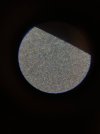We're back to my therapy (cross out and say it's knife sharpening).
Just taking and sharpening the blade after tests wasn't enough for me.
It's kinda, let's say, boring.
I decided to min-max the Z-Tuff steel on my Tyrant Bowie and sharpened it to 150,000 grit (formally it's like a bit over 50 thousand, just by using a combination of abrasive surfaces with diamond pastes that have a suspension-like consistency, it comes out to something like 120-130k grit, but I'll say 150,000 grit—it sounds cooler).
If we're being totally honest, it's down to 0.25 micron. Grits don't mean anything at this point.
I really loved the result I got with Z-Tuff steel at a 22-degree sharpening angle.
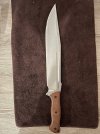
I started with 20/14 micron paste, which is roughly equivalent to about 800 grit. I'm mentioning grits for you to make it clearer, but in reality, diamond paste doesn't have a grit rating as such.
Actually, this is where it becomes clear why I like Z-Tuff.
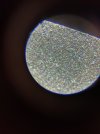
14/10 and in grits that's 1000, just look, honestly, I don't even know what to tell you here
Everything just looks incredibly beautiful.
Structure super nice and clean.
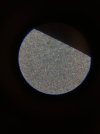
10/7 micron, that's already 2000 grit.
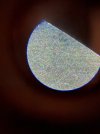
5/3, well, let's say it's around a bit over 3000 grit here.
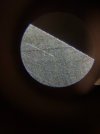
2/1 micron, that's already 5000-6000 grit; this is the trickiest part—the polishing—where I have to make sure I don't lose the carbides but still get a polished edge. Basically, I combine a cast-iron abrasive with the paste and a strip that I stick onto glass; it's a special abrasive-resistant strip that lets me expose the carbides (I'm freaking insane, seriously, guys).
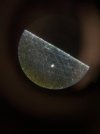
The previous step essentially won't differ much in the intermediate grits, so I'll just jump straight to showing the 0.5–0.25 micron polish I did, while still keeping the carbides intact.

Here's what I love about Z-Tuff?
It's the fact that, from my perspective, this is a real EDC steel you can actually use for cutting tough materials. For example, I often cut reinforced rubber hoses—they have really hard inserts in them—so no stainless steel can handle it due to toughness issues.
Z-Tuff beats even 3V here, believe me—I’ve had around 20 top-tier 3V blades, with hardness from 59 to 64 HRC.
And Z-Tuff outperforms them. I’m confident that if you max out Z-Tuff, it becomes an even more incredible steel.
So, if I wanted an EDC knife I’d use for life, it would be one made of Z-Tuff. By the way, I didn’t say that—Larrin did—but I have a very similar opinion.
Now, microscopy.
You’ll say there are a lot of parasitic scratches here, and here’s my answer:
They’re only visible at 1500x magnification or higher. I use diamond emulsions/pastes with extremely high diamond concentration, and if the concentration were lower, I’d get an edge with no tiny white parasitic marks at all—but! I’d lose the cutting aggression that Z-Tuff has right now.
And aggression is exactly what you don’t want to lose during polishing.
And real tests of course
P.S
Honestly, I'm doing this for the experience and to understand the maximum limits of steel — both in terms of the damage it can withstand and the sharpening, as well as at what cost the restoration of the cutting edge will be achieved after impacts against a steel plate.
It's always very interesting what steel is capable of when you push it to the possible maximum, and even beyond.
Just taking and sharpening the blade after tests wasn't enough for me.
It's kinda, let's say, boring.
I decided to min-max the Z-Tuff steel on my Tyrant Bowie and sharpened it to 150,000 grit (formally it's like a bit over 50 thousand, just by using a combination of abrasive surfaces with diamond pastes that have a suspension-like consistency, it comes out to something like 120-130k grit, but I'll say 150,000 grit—it sounds cooler).
If we're being totally honest, it's down to 0.25 micron. Grits don't mean anything at this point.
I really loved the result I got with Z-Tuff steel at a 22-degree sharpening angle.

I started with 20/14 micron paste, which is roughly equivalent to about 800 grit. I'm mentioning grits for you to make it clearer, but in reality, diamond paste doesn't have a grit rating as such.
Actually, this is where it becomes clear why I like Z-Tuff.

14/10 and in grits that's 1000, just look, honestly, I don't even know what to tell you here
Everything just looks incredibly beautiful.
Structure super nice and clean.

10/7 micron, that's already 2000 grit.

5/3, well, let's say it's around a bit over 3000 grit here.

2/1 micron, that's already 5000-6000 grit; this is the trickiest part—the polishing—where I have to make sure I don't lose the carbides but still get a polished edge. Basically, I combine a cast-iron abrasive with the paste and a strip that I stick onto glass; it's a special abrasive-resistant strip that lets me expose the carbides (I'm freaking insane, seriously, guys).

The previous step essentially won't differ much in the intermediate grits, so I'll just jump straight to showing the 0.5–0.25 micron polish I did, while still keeping the carbides intact.

Here's what I love about Z-Tuff?
It's the fact that, from my perspective, this is a real EDC steel you can actually use for cutting tough materials. For example, I often cut reinforced rubber hoses—they have really hard inserts in them—so no stainless steel can handle it due to toughness issues.
Z-Tuff beats even 3V here, believe me—I’ve had around 20 top-tier 3V blades, with hardness from 59 to 64 HRC.
And Z-Tuff outperforms them. I’m confident that if you max out Z-Tuff, it becomes an even more incredible steel.
So, if I wanted an EDC knife I’d use for life, it would be one made of Z-Tuff. By the way, I didn’t say that—Larrin did—but I have a very similar opinion.
Now, microscopy.
You’ll say there are a lot of parasitic scratches here, and here’s my answer:
They’re only visible at 1500x magnification or higher. I use diamond emulsions/pastes with extremely high diamond concentration, and if the concentration were lower, I’d get an edge with no tiny white parasitic marks at all—but! I’d lose the cutting aggression that Z-Tuff has right now.
And aggression is exactly what you don’t want to lose during polishing.
And real tests of course
P.S
Honestly, I'm doing this for the experience and to understand the maximum limits of steel — both in terms of the damage it can withstand and the sharpening, as well as at what cost the restoration of the cutting edge will be achieved after impacts against a steel plate.
It's always very interesting what steel is capable of when you push it to the possible maximum, and even beyond.

